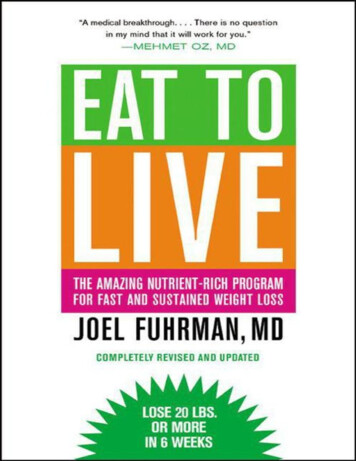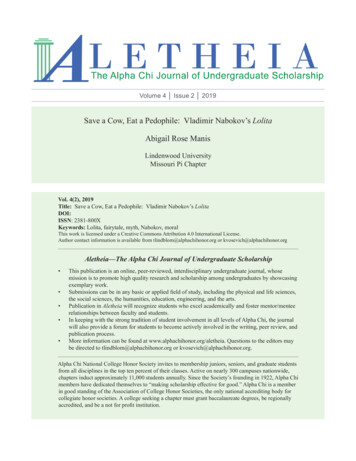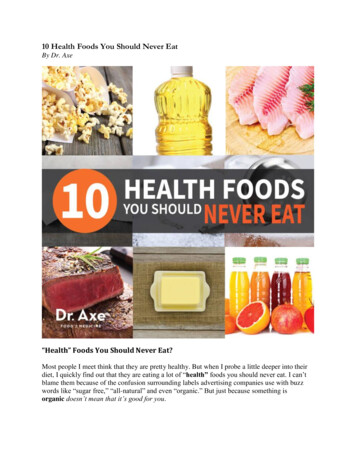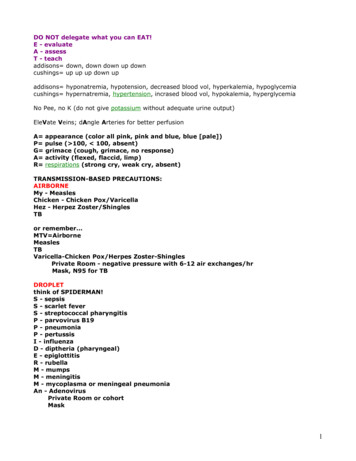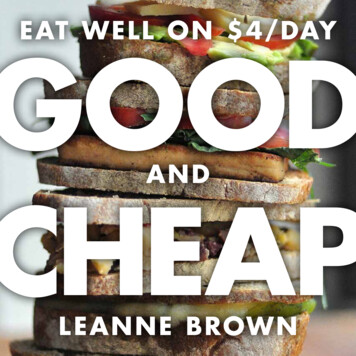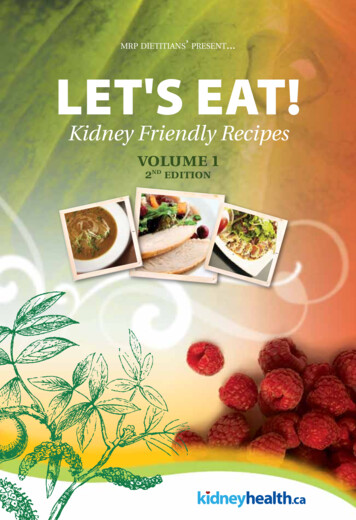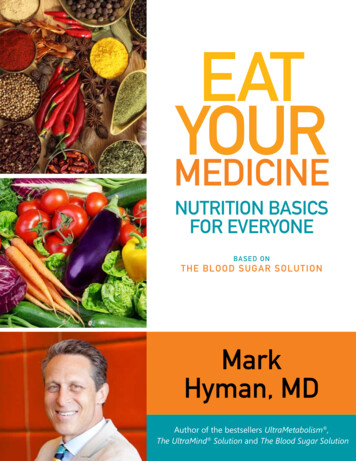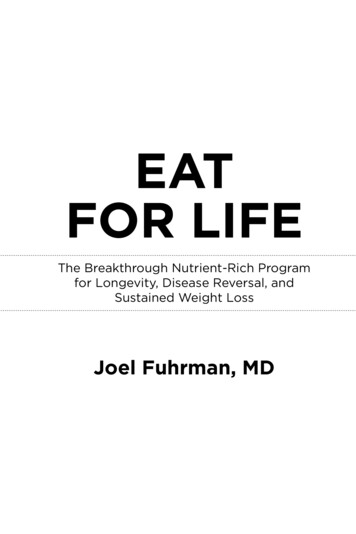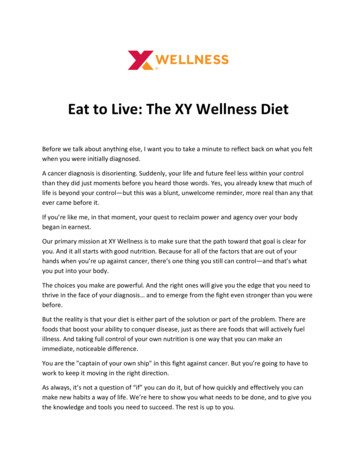
Transcription
Eat to Live: The XY Wellness DietBefore we talk about anything else, I want you to take a minute to reflect back on what you feltwhen you were initially diagnosed.A cancer diagnosis is disorienting. Suddenly, your life and future feel less within your controlthan they did just moments before you heard those words. Yes, you already knew that much oflife is beyond your control—but this was a blunt, unwelcome reminder, more real than any thatever came before it.If you’re like me, in that moment, your quest to reclaim power and agency over your bodybegan in earnest.Our primary mission at XY Wellness is to make sure that the path toward that goal is clear foryou. And it all starts with good nutrition. Because for all of the factors that are out of yourhands when you’re up against cancer, there’s one thing you still can control—and that’s whatyou put into your body.The choices you make are powerful. And the right ones will give you the edge that you need tothrive in the face of your diagnosis and to emerge from the fight even stronger than you werebefore.But the reality is that your diet is either part of the solution or part of the problem. There arefoods that boost your ability to conquer disease, just as there are foods that will actively fuelillness. And taking full control of your own nutrition is one way that you can make animmediate, noticeable difference.You are the "captain of your own ship" in this fight against cancer. But you’re going to have towork to keep it moving in the right direction.As always, it’s not a question of “if” you can do it, but of how quickly and effectively you canmake new habits a way of life. We’re here to show you what needs to be done, and to give youthe knowledge and tools you need to succeed. The rest is up to you.
But let’s be clear: We’re not proposing a deprivation diet. Quite the opposite, in fact.Our goal at XY Wellness—both through our diet plan and our nutritional support regimens—isto transform what you consume into a powerful weapon against cancer. And in the process, weaim to introduce you to the joy and pleasure of preparing and eating real food.Yes, you will have to make some changes. But this new way of eating features fine cuisineunlike any “diet” food you’ve likely had before. So trust us when we say that your family willhappily be joining you for meals. (Be sure to make them do the dishes!)But in order for this to work, we also know it needs to be sustainable. In other words, we’re notinterested in militance at the expense of living. We do, however, want you to finish this reportwith a better understanding of the tradeoffs that you make with every dietary choice. Andarmed with this new awareness, we want you to choose whatever makes the best sense foryou.So don’t be overwhelmed! There’s no need to be, as no one is expecting perfection from you.We are simply here to empower you to make informed choices that reflect your preferencesand priorities.For now, and as always, proceed at a pace that you can sustain. And feel confident in the factthat you are not just taking active measures to boost your body’s innate abilities to ward ofillness, you are also discovering a smarter way of eating—and enjoying—real food like neverbefore.Yours in health,David GuintherCo-founder & CEO of XY Wellness and prostate cancer survivor2
Let food be thy medicineWhen Hippocrates said to “let food be thy medicine,” he obviously wasn’t referring tonutritional supplements. But in today’s world, this wisdom most certainly applies.Understanding the power (and limitations) of the right choices in your fight against cancer isthe first step toward conquering the disease. So let’s start by talking about what a smart dietcan’t do.Scientific research has identified a number of natural compounds that are efficacious in thetreatment of cancer. Unfortunately, there is frequently no practical or realistic way to ingestthe recommended, therapeutic daily dosage through diet alone.For example, studies indicate that a compound found in red wine called resveratrol has anticancer, anti-inflammatory, anti-aging, and anti-diabetic benefits. The recommended dosage is100 mg per day—the amount you would find in approximately 125 glasses of red wineI don’t know about you, but this is one case where I am going to go with the high-quality dietarysupplement alternative.At XY Wellness, we formulate dietary supplements to deliver necessary, condition-specificcompounds in quantities that diet alone cannot. This diet will provide a great foundation tobuild upon, but build upon it we must.That being said, smart lifestyle choices contribute not just to your quality of life, but also toyour ability to combat disease.Your choices—with respect to diet, exercise, stress management, sleep quality, andsupplementation—all complement each other. Good choices and habits have a synergisticpositive effect, just as poor choices and habits have a synergistic negative effect.If you are willing to establish the right habits, you are putting yourself into the best possibleposition to improve your prognosis and quality of life. With that, let’s go over the seven coreprinciples of the XY Wellness Diet:1. Cancer-fighting: It’s abundant in phytonutrients that actively inhibit cancer growth.2. Anti-inflammatory: It minimizes gluten, dairy, and other inflammatory triggers.3. Immune system boosting: It’s rich in antioxidants and immune system enhancers.3
4. Low-glycemic: It’s free of granulated sugar and low in refined flour.5. Pesticide-free: It’s organic when necessary, yet "conventional" when appropriate.6. Delicious: It’s fresh, local, top-quality, enzyme-rich, vibrant, clean cuisine.7. Doable: There may be a learning curve, but it’s nothing that you can’t easily master.In this report, we’ll go over each one of these core principles and explain why they’re soessential for thriving in the wake of your diagnosis. Remember, you are in complete control ofwhat you put into your own body.Isn't it time to use this power wisely?Putting out the fireDigestion should not be a stressful process for you or for your cells. This is why one of the firstprinciples of our diet is minimizing inflammation. You have probably heard from health expertsthat inflammatory foods are “bad” and important to avoid.But eating these foods doesn’t always cause visible problems. And because of that, it can behard for this message to really sink in. So let’s start out by talking about what inflammation isand how it affects your body.Inflammation has earned its place among the negatively charged health buzzwords of our time,but it is not bad in itself. It’s your body’s natural response to threats such as injuries, infections,and viruses.In other words, the body can’t heal properly without becoming inflamed. But this acuteinflammation isn’t the type that we’re talking about here.The kind of inflammation that we aim to minimize in the XY W diet is systemic, chronic,unnecessary inflammation—the kind that leads to disease. (For example, any disease ending in"-itis"—e.g., prostatitis, arthritis, bronchitis, etc.—refers to an inflammatory condition.)Inflammation is a leading factor in the development of cancer, and has a number of differentcauses: Infections, including viruses, bacteria, parasites, and fungi4
Surgery (e.g., Radical Prostatectomy, Brachytherapy)Physical Trauma such as tissue damage due to collision, radiation (e.g., EBRT), burns, orfrostbiteVaccinationsChemicals, in particular pesticides and household cleaning productsHigh Blood PressureHigh Estrogen levelsSmokingSugar and Processed FoodsFree RadicalsObesityChronic FatigueHypersensitivity Reactions, such as overly powerful allergic reactionsBut the good news is that you can easily reduce your body’s inflammatory burden with a fewsimple dietary modifications. More specifically, anti-inflammatory eating means minimizing oreliminating from your diet the various food-related triggers of inflammatory responses in yourbody—and a few big players, in particular.Minimize your consumption of gluten.Gluten is a protein in wheat and other grains. For men who are either sensitive or allergic togluten, this protein is highly inflammatory. And the bad news is that it’s more common thanyou might think.Celiac disease is the most severe form of gluten allergy, and is a genetic autoimmune disorder.But gluten sensitivity can manifest with varying degrees of severity. Clinical evidence suggeststhat more than half of all those tested show signs of some level of gluten intolerance.You can have your doctor test you for gluten sensitivity, but a more accurate and effectivemode of assessment is through the elimination diet. This simply involves eliminating all glutenproducts and then gradually reintroducing them while monitoring any potential allergicreactions or discomfort such as skin rashes, stuffy nose, tiredness, mental fatigue, feeling ofbloated-ness, or itchy skin.Because blood tests are notoriously unreliable, and sensitivities can develop at any time,limiting your exposure to gluten is advisable even if you’re unsure as to your sensitivity togluten. The easiest way to do this? Simply reducing your intake of simple carbs such as flour,which will naturally reduce your exposure to wheat gluten. But if you notice signs of sensitivity(or worse) the best course of action is to eliminate gluten from your diet altogether.5
Be aware that gluten is hidden everywhere, especially in processed foods. Why? Because it’scheap. For example, even soy sauce or caramel sauce contain gluten. So be vigilant and on thelookout for these stealthy terms for or sources of gluten:BindersBranCereal bindingDurumFarinaHydrolyzed vegetableproteinMaltMatzoBlue CheeseBrewer’s yeastChiltonEdible iersHydrolyzed plant proteinKashaMalt flavoringModified food starch"Natural" flavorSemolinaRyeSome spice mixturesMalt vinegarMonosodium glutamate(MSG)SeitanSoy sauceSpeltTeriyaki sauceWheat proteinStabilizerTextured Vegetable Protein(TVP)SuetWheat germThe best alternative to gluten-filled packaged and processed foods are fresh, whole, naturallygluten-free foods. There are plenty of them!That said, as awareness of gluten-sensitivity or intolerance has increased, so have the varietyand quality of gluten-free packaged alternatives. Seek out any of these great options, to namejust a few: Baking Mix: Pamela's Products, Simple Mills, or Bob's Red MillPizza Crusts: Udi's GF Thin Crust or Simple Mills GF Pizza Dough MixPasta: Trader Joe's Brown Rice Pasta or Bionatura Rice/Potato/Soy PastaCrackers: Mary's Gone Crackers or Back To Nature Gluten-freeBread: Udi's GF Whole Grain or WFM Bakehouse GF Whole GrainEnergy Bars: Picky Bars or Vega Sport Protein BarsBeer: Green's Endeavor or Brunehaut Bio BlondeSoy Sauce: San-J Tamari Wheat-Free6
Minimize your consumption of conventionally raised dairy and meat.The types of saturated fat found in most dairy products make it a common inflammatory foodgroup. And just as with gluten, you may not realize that you are intolerant.Research has also linked high dairy consumption to prostate cancer risk, not least of all due tothe high levels of hormones found in most commercial dairy products.Likewise, nearly all factory-farmed meats are injected with or exposed to steroids andhormones. One of the many consequences of this is that these meats are high in arachodonicacid, which produces inflammation.So look for the following when shopping for or ordering meat: eeMeanwhile, if you know or suspect that you are sensitive to dairy, work towards eliminating itfrom your diet. That fresh mozzarella or four-year-aged cheddar is not worth it when to keep inmind our goal of strengthening, not taxing, your body.Be aware that dairy is hidden everywhere, especially in processed foods. Why? It is cheap. Sobe vigilant and on the lookout for these stealthy terms for or sources of dairy: CaseinCaseinateWheyLactalbuminLactoglobulinThere are plenty of great substitutes for animal milk, including almond milk, and coconut milk.In terms of cheese, other than some nice nut cheeses there are not what we consider to begreat substitutes, but depending on your intended use (e.g., on crackers), there are some greatalternatives to consider such as:Olive tapenade Hummus 7
Baba GanoushIf your craving for dairy is strong, this may well be a sign that you are indeed sensitive or allergicto it since research shows that we frequently crave foods that we are allergic to. That said, in apinch, we recommend the option of an unsweetened, all natural, nonfat, hormone-free, Greekstyle strained yogurt such as FAGE.Increase your consumption of anti-inflammatory foods.Elimination is just one half of the battle against chronic inflammation. You can also effectivelycounteract it by suppressing key players in the inflammatory process, such as NFkappaB andCOX-2 enzymes. And believe it or not, doing so without drugs is actually easy.One of the best ways is to add a wide variety of anti-inflammatory spices and herbs to yourdishes: iseRed ChiliYou will also want to seek out foods that are abundant in omega-3 fats. These essential fattyacids not only inhibit inflammation, they:Lower cholesterol and triglycerides Prevent cancer cell growth Reduce high blood pressure Regulate food intake, body weight, and metabolism Some great sources of Omega-3 Fatty Acids include:Seeds and their oils, such as flax, grapeseed, and pumpkin oils Nuts and their oils, such as almonds, walnuts, and cashews Olives and olive oil Fish oils and certain fish, such as wild salmon, mackerel, and sardines 8
Ultimately, we know that chronic inflammation poses a material risk to our health and ourability to combat disease. And we know that we can reduce our exposure to inflammatoryagents by simply making smarter dietary and lifestyle choices.So while removing all of these triggers from your diet may seem extreme, give it a try. You willlikely find that it’s not as difficult as you think. And, if during the initial few days you feel as ifyou are experiencing something akin to withdrawal symptoms, then there’s a good chance youare thus reinforcing the need for change overall.Arming your immune systemLife is about choices. We have complete control over what we eat. The reality is that throughthe choices we make, we are either working for or against our own best interests. The rightfood choices will boost our immune system, while the wrong choices will tax or compromise it.Here’s why that’s important: Your first—and best—defense against cancer is your body’s ownimmune system.There are foods that will boost your body's natural ability to fight disease, just as there arefoods that will suppress this ability. So how can you fortify these defenses through your diet?The strategy is simple Eat foods that are low on the glycemic index scale. High blood sugar needlessly taxes yourimmune system. And, in fact, a single tablespoon of sugar will leave your immune systemworking at half capacity for 4 or more hours? So to keep your blood sugar steady, werecommend that you eat a low GI diet. (More about that in the next section.)Eat antioxidant-rich foods. Once again, your immune system is your primary natural defenseagainst disease. Antioxidants mobilize our immune cells and combat cellular damage bycollecting free radicals that fuel cancer, cause lung and heart damage, skin degeneration,muscular soreness, and fatigue.High antioxidant foods include: Fruits: especially blueberries, oranges, watermelon, tomatoes, grapes, raspberries, acai,cranberries, and strawberries. Berries are among the most pesticide laden conventionalfruits, so always buy them in organic form.Vegetables: especially leafy green vegetables (like spinach, kale, chard, mustard greens),carrots, yellow peppers, and sweet potatoes.Nuts: especially almonds.Tea: especially Green and Rooibos.9
Blue-green algae: especially spirulina, chlorella, and seaweed. Blend them into asmoothie.Eat more garlic and onions. Although not breath-friendly, they are rich in sulfurcompounds that boost the activity of natural killer ("NK") cells and T-helper cells, whichmanage your immune system.Eat more mushrooms and seaweed. They also boost NK cell activity. Good choices includeAgaricus, Shitake, and Maitake—and Nori, Wakame, Kombu, Arame, and Dulse.Avoid crap whenever possible. You know what we’re talking about. Try to avoid beverages thathave added sugar. Try to reduce the amount of refined flour in your diet. And always recognizethat "convenience" does not require a bad dietary choice.Reining in runaway blood sugarBeyond the serious problem of diabetes, high glycemic foods like sugar feed cancer bygenerating excess insulin and insulin growth factors. As we mentioned above, high glycemicfoods also suppress our immune system.Since your post-diagnosis body cannot afford to be taxed this way, high glycemic foods simplyhave to go. This obviously includes refined flour and simple carbohydrates.For example, "white foods” such as mashed potatoes, white pasta, white bread, and white ricemight as well be sugar since they metabolize in similar ways. Another example is corn syrup,which is a hidden simple carbohydrate in many processed foods. It metabolizes at lightningspeed, causing an even more rapid spike in blood glucose and insulin release than sugar does.Remember that your daily goal is to create a truly hostile environment for prostate cancer, tobecome even more of an inhospitable host. You want to boost your body's innate ability togenerate healthy cells and to suppress further generation of aberrant cells. And that meansavoiding anything that will tax your immune system or damage your body's ability tosuccessfully battle the disease.What is captured in a glycemic score?The glycemic index (GI) measures the amount by which a particular food increases your bloodsugar compared to the amount by which the same quantity of white bread would increase it. GIis a system designed to rank foods according to their affect on your blood sugar level. Itmeasures how quickly a food converts to sugar.10
Foods with carbohydrates that break down rapidly cause a dramatic rise in your blood sugarand insulin levels largely because your body needs less energy to convert such foods into sugar.These foods are assigned higher numbers on the GI scale. Foods with lower numbers will causeyour blood sugar to rise and then fall more slowly than will foods with higher numbers, andhave been shown to satisfy hunger longer and minimize food cravings.The GI value of a food can vary depending on a number of factors such as ripeness, storagetime, cooking method, variety, and the food combination in the meal. Foods with a GI score of55 or less are defined as "low GI" and foods a GI score of 70 or above are defined as "high GI."An alternative measure, the glycemic load (GL), may be a more accurate indicator ofcarbohydrate conversion and its effect on your blood sugar and insulin levels because itprovides a measure of an overall impact on our blood sugar and insulin level. Foods with a GLscore of 10 or less are defined as "low GL" and foods a GL score of 20 or above are defined as"high GL."The are many publicly available listings of the GI and GL values of popular foods, along withtheir carbohydrate content. Pick one up and refer to it while planning meals and shopping.Eventually, you will know what you are looking to load up on and what you are looking to avoid.So what do I need to do?Keep your food choices as low on the glycemic index and glycemic load scale as possible. Alsopair or combine food choices to minimize their glycemic impact. Proteins and healthy fats lowerthe spike in your blood sugar, so being mindful of food combinations will help you in a pinch.For example, a banana with almond butter is far better for you than a banana alone.For simplicity, here is a sample of foods to load up on: Organic vegetables, including asparagus, broccoli, cucumbers, lettuce, spinach, andzucchiniOrganic, free-range eggsFree-range, grass-fed meatsWild-caught salmon and other cold water fishNuts, including almonds, cashews, and walnutsOlive oilBeans, including black, chickpea, and lentilsHigh protein grains, in particular quinoaOrganic fruit when eaten in combination with a protein or healthy fat11
Nonfat plain Greek yogurtAnd here is a sample of foods to reduce your consumption of or avoid altogether: Sugar, including corn syrupProcessed foods, including bread, pasta, and crackersLow protein grains, including white and brown riceDairy, with the exception of non-fat Greek yogurtLimit fruit intake unless eaten in combination with a protein or healthy fatStarchy vegetables such as white potatoesWhat about my need to feed my "sweet tooth?"Try to get over it by remembering your priorities. That said, some sugar substitutes are healthy,while some others are not. Avoid artificial sweeteners such as aspartame, sucralose, andsaccharine since they are comprised of synthetic chemicals, which will increase the toxic burdenon your body. Instead, stick to natural sugar substitutes such as stevia and erythritol. These aregood options in moderation.A few words about protein and fatProtein is essential to a wide range of bodily functions and in building and repairing muscle. Noargument there. What we do object to is how the meat and dairy industries have spentmillions, if not billions, on convincing us that the only source of high quality protein are theirproducts.This is simply not true.Proteins consist of twenty amino acids, of which eleven are naturally synthesized by our body.We are able to get the remaining nine, which are also known as Essential Amino Acids, from thefoods we eat and the nutritional support with which we complement our diet.So to be clear, our bodies need to ingest these nine Essential Amino Acids, not protein per se.This is a key point since these Essential Amino Acids are available from a wide variety of plantbased foods, and thus are certainly not the exclusive domain of animal products.The argument that animal-based protein is more complete is disingenuous. Although ourbodies process plant-based Essential Amino Acids differently, the net result is the same withone exception: Plant-based sources do not bring with them the saturated fat and casein presentin meat and dairy.12
The truth is that a whole food, plant-based diet will give you everything that you need to behealthy and to function at peak levels. As with any diet, you need to be smart about it in termsof making sound choices and incorporating a wide variety of foods such as: Nuts and Nut ButtersSeeds (e.g., chia, sesame, sunflower)Legumes (e.g., green peas, edamame, chickpeas)Grains (e.g., quinoa)Vegetables (e.g., leafy greens)So do not be fooled by food industry marketing campaigns. You can ingest an ample supply ofEssential Amino Acids without consuming any dairy or meat products.Find a dietary regimen that works well for you, but ensure that it consists of whole foods and isprimarily plant-based. There are lean sources of animal protein, of course, so once again, findwhat works best for you and stick to it.Don’t skimp on omega-3sAnother common misconception to tackle is the common narrative around fat—namely, thatit’s something to be avoided.In the XY Wellness diet, there are two kinds of healthy fats: monounsaturated (MUFA) andpolyunsaturated (PUFA). Unsaturated fatty acids are made up of either one (mono-) or multiple(poly-) unsaturated fatty acid chains stuck to a phosphate molecule, which carries the chainswherever they need to go.Generally, you find PUFAs in plants and fish, MUFAs in only plants. One of the most importanthealthy fats for your daily thriving is omega-3.Omega-3 fatty acids are one kind of essential PUFA that plays an important role in braindevelopment and normal growth in the rest of your body. They’re called “essential fatty acids”because the human body can’t produce enough of them on its own; it has to get them fromfood. More specifically, we get them from fatty fish.Omega-3s are useful to us men for two main reasons. First of all, a healthy amount of omega-3sis consistently associated with a drop in cardiovascular risk. But in addition to reducing the riskof heart disease, they carry a specific benefit for middle-aged men.13
Research shows that men can decrease their risk of prostate cancer by taking an omega-3supplement twice a week. A critical analysis recently published in the Proceedings of MayoClinic confirmed this knowledgeDespite some controversy, the evidence points most consistently toward omega-3supplementation and fatty fish consumption. Two supplements or two servings a week will do,and we recommend wild-caught salmon, herring, mackerel, anchovies, or sardines.More cancer-specific food “cures”No, we don’t mean literal cures—if only it were that simple. But the fact is, doubling down oncertain choices can make a very dramatic difference.The kinds of fat that you consume, for instance, have a strong impact on your cancer risk. Oneof the most recent articles on the subject identified walnut-derived fats as potential cancerfighters. Researchers found that this fat not only decreased rats’ cholesterol, but also slowedthe growth of their prostate cancer Animal fat, by contrast, was recently found to speed up thegrowth of cancerBut fat is not the only factor. Recent research has pinpointed countless foods that actively workagainst cancer. Such foods counter the activity of free radicals and induce cell death in tumorsPhenolic compounds such as those found in curcumin and green tea actively combatdeveloping cancer cells. In addition, cruciferous vegetables such as broccoli, cauliflower, andBrussels sprouts contain high levels of sulphuric compounds, which induce special enzymes thatdetoxify the body.We could go on and on about the evidence, but in the interest of keeping it simple, we like tocite the “ABCs” of cancer-fighting foods:!Antioxidants. Look for these crucial chemicals in berries and green or black tea.!Beta-carotene. This helpful compound can be found in carrots, sweet potatoes, andcitrus fruits.!Cruciferous vegetables. Your best bets are broccoli, cauliflower, and Brussels sprouts.!D, the Vitamin. Fill up on fatty fish, and spend some time in the sunshine to make itcount.14
!Epicatechins. These cancer-fighting compounds can be found in several kinds of tea, andthey also appear in chocolate, in small amounts.!Friendly fats. The friendliest fats are monounsaturated and are found in fruits,vegetables, and nuts. Avocados, flaxseed, sunflower seeds, and walnuts are our go-tofatty friends. (And don’t forget your Omega-3s, listed below.)!Grapes and Garlic. Grapes contain resveratrol, which has been shown to aid in the fightfor health, and alliums like garlic and onions have been shown to be incredibly hostile tocancer growth.!Horseradish. Spice up sliced tomatoes or fresh fish with this cancer-fighting crucifer.!Indoles and isothiocyanates, which can be found in kale, broccoli, cabbage, andcauliflower.!Jalapeños, which contain capsaicin, a well-known cancer-fighter.!K2, the vitamin. This one has been shown to support healthy heart function and fightprostate cancer.!Lycopene, which is found in tomatoes—especially tomato sauce.!Mushrooms. We recommend Reishi, Maitake, Agaricus blazei Murill, and CoriolusVeriscolor, which contain lectin and polysaccharides such as lentinan.!Nuts, depending on the variety, can contain quercitin, campferol, or selenium.!Omega-3 fatty acids. As mentioned above, look for these in wild-caught salmon andother kinds of fish.!Polyphenols, a specific kind of antioxidant, which can be found in grapes, grapeproducts such as wine, and many other fruits.!Quercetin, mentioned briefly above. This is a helpful flavanol found in fruits andvegetables which has been shown to increase immunity.!Resveratrol, found in small amounts in red wine. We recommend taking resveratrol insupplement form.!Sulphuric compounds, which are the crucial compound in cruciferous vegetables.15
!Turmeric, a delicious, cancer-fighting spice.!Unwind. Okay, so it’s not a food. But chronic stress is strongly associated with anincreased risk of cancer, so it’s essential that you make time to decompress.!Variety of Vegetables. You can’t go wrong chomping on a different vegetable everyday.!Water. Make plain old water your go-to beverage. It will rehydrate you without anyadded sugars or other artificial ingredients.!X-ercise! With every good food there is a good workout to metabolize it. Keep yourbody fueled for movement.!Yams, which, some evidence suggests, can inhibit the activity of free radicals!Vitamin Z, i.e. a good night’s sleep. Again, not a food—but it’s every bit as important.Catch your daily recommended value of Zs (between six to eight hours) every night toreduce your risk of cancer, as well as reduce your stress.Hit every “letter” on this list, and your body will be armed with all of the tools it needs to thrivein the wake of your diagnosis.Eating fresh, eating clean, eating smartAs you seek to boost your body's ability to combat illness and disease, the last thing you wantto do is handicap your efforts with unnecessary, avoidable exposure to toxins such aspesticides. That’s why it’s so important to make smart choices about what you put into yourshopping cart and onto your plate."Conventional" produce is exposed to pesticides (e.g., herbicides, insecticides, and fungicides)that cannot always be completely washed away. By contrast, "organic" produce is not exposedto pesticides. In other words,Conventional Organic PesticidesYou would not choose to add a sprinkle of pesticides to food you are about to eat, but this iswhat you are in effect doing with at least a subset of "conventional" pro
inflammation isn’t the type that we’re talking about here. The kind of inflammation that we aim to minimize in the XY W diet is systemic, chronic, unnecessary inflammation—the kind that leads to disease. (For example, any disease ending in "-itis"—e.g., prostatitis, arthriti
